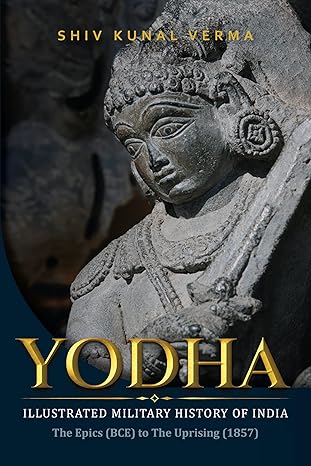When Persia, Iran, attacked India for insult of envoy

Image credit The Browser
‘Yodha: Illustrated Military History of India’ spotlights war tales & strategies
Military historian Shiv Kunal Verma in his new book ‘Yodha: Illustrated Military History of India – The Epics (BCE) to the Uprising (1857) – has documented pivotal wars fought on the land of India. With 1600 exclusive illustrations, Verma’s book is a visual delight for the readers.
Verma with crisp and concise approach refreshes memories of the wars which may have ebbed in popular memories. Wars are fought with strategies. Verma examines the strategies deployed by the war actors of the bygone era.
The military historian spotlights fragmented Indian principalities when India faced marauding foreign attacks. Indeed, the kings were found to be sitting ducks who were slayed by superior horse powers of the foreigners and better military arsenals.
Also Read: ‘The Collector’s Mother’ traces journey from extreme poverty to IAS
Verma’s book, thus, gains significance to spotlight the need for relentless invention, innovation, and ingenuity to face emerging military challenges.
Excerpts from two chapters are here shared with permission from The Browser, the publisher of ‘Yodha: Illustrated Military History of India – The Epics (BCE) to the Uprising (1857).
Nader Shah (1739 CE)
Nader Shah justified his invasion of India in 1739 on the grounds that the Mughal Emperor Muhammad Shah had insulted the Persian envoy at the Delhi Imperial Court. The governor of Punjab asked to strengthen the defences after Nader Shah crossed the Khyber Pass, but the Mughal emperor disregarded his appeal.
Meeting perfunctory opposition, Nader Shah swept through the Mughal Empire’s western frontiers capturing Ghazni, Kabul, and Lahore.
With the Persian, also known as Alexander the Second, easily running through Punjab, Muhammad Shah, along with a few allies, finally confronted him at Karnal. The two armies collided head-on, but the Mughal Army was soon surrounded and routed.
Saadat Khan, the Nawab of Awadh, was captured, and there was disarray within the Mughal army’s ranks. Muhammad Shah’s general, Nizamul-Mulk, convinced Nadir Shah to return to Persia in exchange for 20 million rupees, acting as a go-between.
Also Read: Book on Vijay Raman, Pan Singh Tomar encounter fame, unveiled
Pleased with Nizam’s diplomatic skills, the Mughal emperor named him Amir-ul-Umra and made him the wazir. The envious Saadat Khan, who was being held prisoner, told Nader Shah not to be content with such a trifling amount, which even a province governor could provide.
The fabled wealth of the Mughals was his for the asking, and the Persian king arrived in Delhi accompanied by the humbled Mughal Emperor. The keys of the Delhi Fort and treasure had already been surrendered.
Nader Shah had already been paid the earlier agreed amount in exchange for his return. However, a rumour spread that Nader Shah had passed away. A few Persian soldiers were killed in the Delhi riots that were set off by this news.
A furious Nader Shah issued an order for the widespread killing of the populace in any area where Persian soldier corpses had been discovered. Consequently, the citizens of Delhi were massacred and pillaged, resulting in the death of two lakh people.
In addition to the war booty, he made sure to add about 100 elephants, 7,000 craftsmen, 200 carpenters, and 100 stonecutters to his train, totalling over 700 million rupees in loot.
Subedars of Arcot (1692-1710 CE)
Aurangzeb’s policy that ‘my enemy’s enemy is my friend’, as had been the case with the British and Shivaji vis a vis Bombay, resulted in the setting up of the Arcot Dynasty. The Mughal emperor’s armies were being challenged by Marathas in the Deccan and the south and by the end of the seventeenth century, he invited Zulfikar Ali Khan to take on the Marathas.
At that time, the Marathas were dominating south Carnatic from Gingee Fort, but Zulfikar Ali Khan gave a decisive blow to the power of Rajaram, their king. In 1690 the siege of Jinji was assigned to him and would continue for eight years.
Though Aurangzeb was unhappy with Zulfikar Ali Khan for failing to capture Rajaram, his political fortunes continued to grow as he was promoted.
Also Read: The fall of Kabul spotlights chaotic Afghanistan
In 1692, he was appointed by Aurangzeb as the faujdar of the Carnatic with his seat at Arcot, and he was no longer under the legal purview of the Nizam of Hyderabad as the Carnatic had, until then, been a part of the Golconda Sultanate.
Post 1703, Aurangzeb sent Zulfikar Ali Khan on various assignments to combat the Maratha insurgency, during which time his subordinate, Daud Khan Panni, an Afghan nobleman and military commander of the Mughal Empire, served as the deputy faujdar.
In 1705, after the Siege of Wagingera, Zulfikar came under a cloud for he had let Pidia Nayak escape. In 1710, Saadatullah Khan I was appointed the Mughal governor of the Carnatic after Daud Khan Panni moved to Gujarat as the governor.
Belonging to the Navaiyit family, a subgroup of Konkani Muslims who were considered to be of Arab descent, Saadatullah Khan I would go on to become the first Nawab of the Carnatic, with active support from Daud Khan Panni.
Join WhatsApp channel of The Raisina Hills







